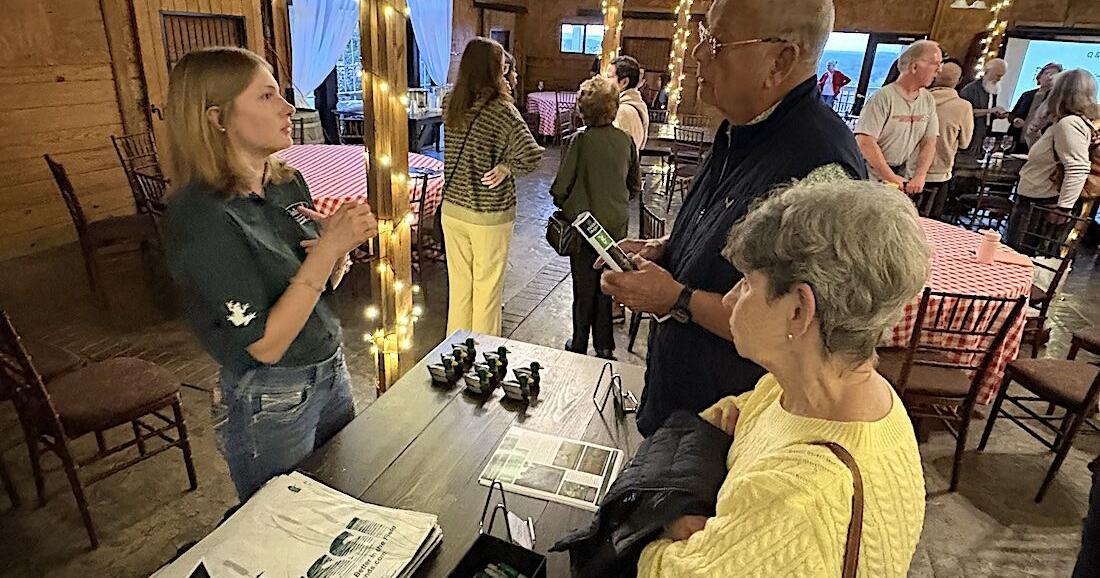Work to curb the spread of invasive plant species continues to ramp up as the county government rolls out a $2 million grant program to support efforts by community groups and landowners.
The county plans to award grants ranging from $5,000 to $50,000 to help remove invasive plants including invasive plants like Bradford Pears, English ivy, Japanese barberry, and Japanese stilt grass from the local landscape.
The application window opens Monday.
The program grew out of the work of the volunteer Loudoun Invasive Removal Alliance, which has spent several years educating homeowners associations and others on the impacts of invasive plants.
This week, LIRA President Mike Littman led a second public information session about the project for community members gathered at Bluemont Vineyards.
“This is not just about the environment. It’s about health and safety. It’s about the economy, specifically the rural economy,” he said, noting the dangers of Bradford pear trees coming down during storms, the smothering impacts of English ivy, and the tick-supporting properties of the Japanese barberry. The availability of tree of heaven plants greatly accelerates the growth of the spotted lanternfly population, a significant threat to Loudoun’s wine industry.
While Littman has been the county’s leading preacher against invasives, he has recruited a growing roster of disciples in the effort.
During the Sept. 10 forum, Supervisor Sylvia Glass (D-Broad Run), state Sen. Russet Perry (D-31) and U.S. Rep. Suhas Subramanyam (D-VA-10th) each spoke about the importance of the campaign.
“Not long ago, like many of us, I had very little understanding about how damaging invasives were,” Glass said “I thought many of them were beautiful, and accepted them as part of our environment, until I was educated about how damaging invasives can be to our health and our safety.”
She gained first-hand experience when a Bradford pear tree in her yard blew over in a storm.
Perry chairs the senate’s Rural Affairs subcommittee.
“I was out here doing a farm tour leading some other legislators a of couple years ago, and we came across lantern flies and lantern flies and lantern flies,” she said. “It became very apparent to me … that this is really a pressing issue that was really hurting our agriculture and our folks here in this community.”
She’s worked to get funding support Virginia Tech research on how to combat the pest and also worked for legislation to discourage the sale of invasive plants in the state.
Subramanyam said he wants to do that work at the federal level.
“I bought a house in eastern Loudon about four or five years ago, and my wife ended up doing the Virginia Master Naturalist program, and she quickly identified that we had a Callery pear in our front yard. So we cut it down last year,” he said.
“Let’s work on a bill together on Capitol Hill. Let’s pass a bill in Congress on invasive plants. Let’s make sure that we can get whatever agency needs it, whatever group needs it, whatever experts need it, the resources they need to address it head on,” Subramanyam said. “This is something that will be a legacy for our kids, for our grandkids. This is something we can do that’s great for the environment and great for our kids’ future.”
The county’s grant program builds on the work completed during pilot projects conducted last year.
The new grant program is open to property owners in Loudoun who have invasive plants on their property, including homeowner association-managed property. Reimbursement is provided upon verification of completed work.
The first round of applications will be accepted from Sept. 15- 26 with a new application cycle opening approximately every two months. The application includes a project overview, a cost estimate from a contractor who meets the county’s requirements, and supporting documentation. County staff members and contractors specializing in invasive plants are available to help applicants through the process.
Littman thanked the community members who attended the briefing.
“You’re making a difference in something. This wasn’t on the radar a couple years ago, and it’s definitely changing quickly,” he said. “This is part of a unique movement that will shape the landscape of Loudoun for years to come.”

